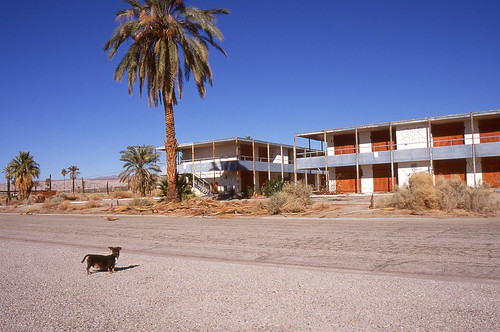The Salton Sea is a fascinating case study in the cultural ambiguity of “nature”. Created in 1905 when the Colorado River found a hole in a poorly constructed irrigation intake and flooded low-lying California desert, the Sea has been sustained – sort of – by agricultural runoff. So it’s not at all “natural” by one clear meaning of the word. But it’s there, and its continued shrinkage as a result of evaporation poses huge problems, as detailed in a piece in today’s edition of the Desert Sun:
Sport fishing was first promoted at the Salton Sea in 1907, according to the authority. The sea became a playground for Hollywood stars and others who loved boating and fishing.
Tourism has declined with fish die-offs and the smell created by occasional emissions of hydrogen sulfide. But the area still gets about 150,000 visitors a year.
“It could be such an economic boon,” Larson said.
While the recreational possibilities and visions of shoreline development are intriguing, the biggest reason to be concerned about the Salton Sea is the growing threat to air quality in the Imperial and Coachella valleys.
As the sea level declines and the shoreline recedes, more areas of dry lake bed, or playa, are exposed. The playa is covered with fine sediments deposited at the bottom of the lake. When the winds kick up, particulate matter goes airborne.
The estimated price tag to fix all of this, via a grandiose scheme of hydraulic engineering, is $9 billion, a number so large that it’s almost not worth a serious conversation. If you listen to the rhetoric of the community supporting action, clearly part of the argument is an unwillingness to abandon this crazy notion that we’d have a Riviera in the desert there, if only….
But given the unreality of state or federal spending that large, what should or can be done?
(photo courtesy Omar Omar, licensed under Creative Commons)


A couple of years ago, our local Audubon Society (in San Diego) was supporting a “low-build” option that would cost much less (millions, not billions, if I remember), and focus on ways to preserve the sea as an important stop on the Pacific Flyway. Apparently, there are ways to do that without the massive engineering required in the $9 billion plan.
Abandon that toilet — it’s worse than it was 100 years ago (before the flood) — pave it over if you’re worried about toxic dust (I am only half kidding). If you want to restore something, do the Colorado Delta. Here’s my radical proposal 🙂
http://aguanomics.com/2008/12/fixing-socal.html
ps: more posts: http://aguanomics.com/search/label/Salton%20Sea
As the dose makes the poison, the return makes the investment. The question is not that 9 billion is large, but that it would or would not have a proportionate benefit.
OTOH Eli always favors flyways. One of the neatest conservation things in the US is how duck stamps preserved the East Coast flyway. There are bird refuges (just visited one on the Eastern Shore of MD) where farmers are allowed to grow crops if they leave some of it for the birds to eat on their ways north and south.